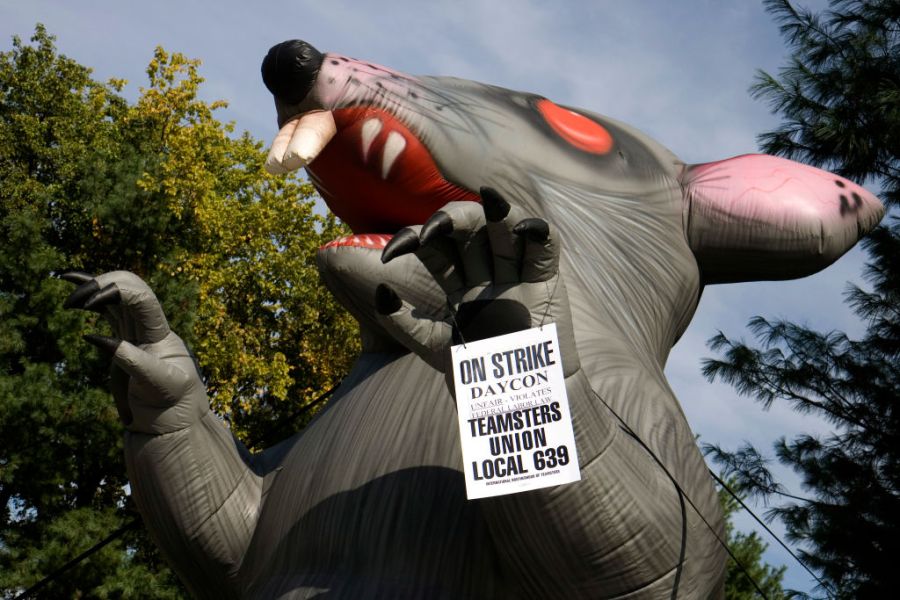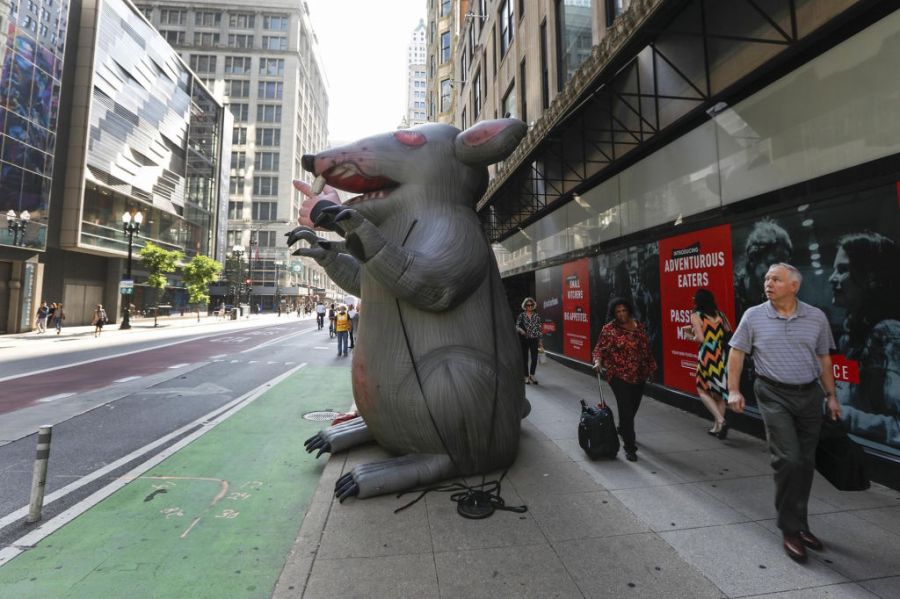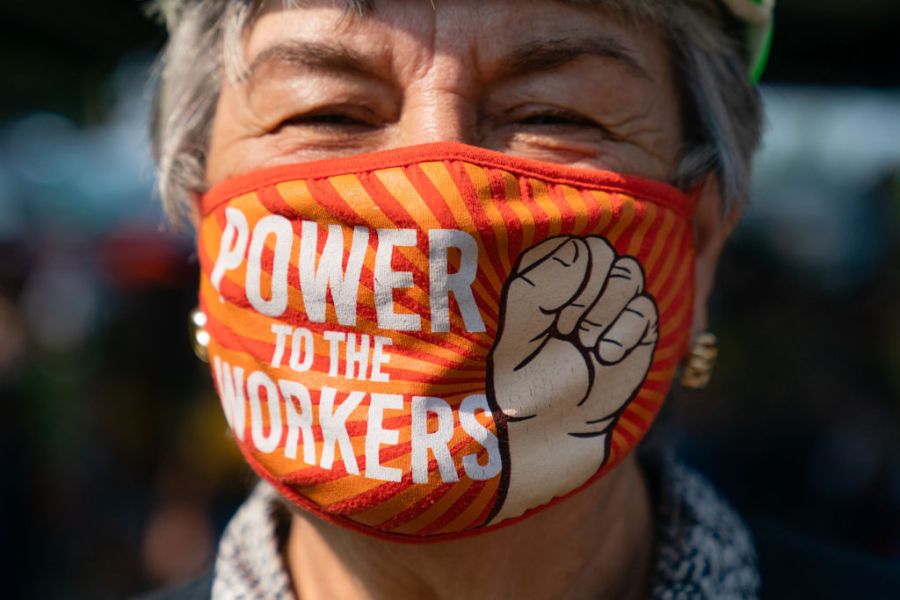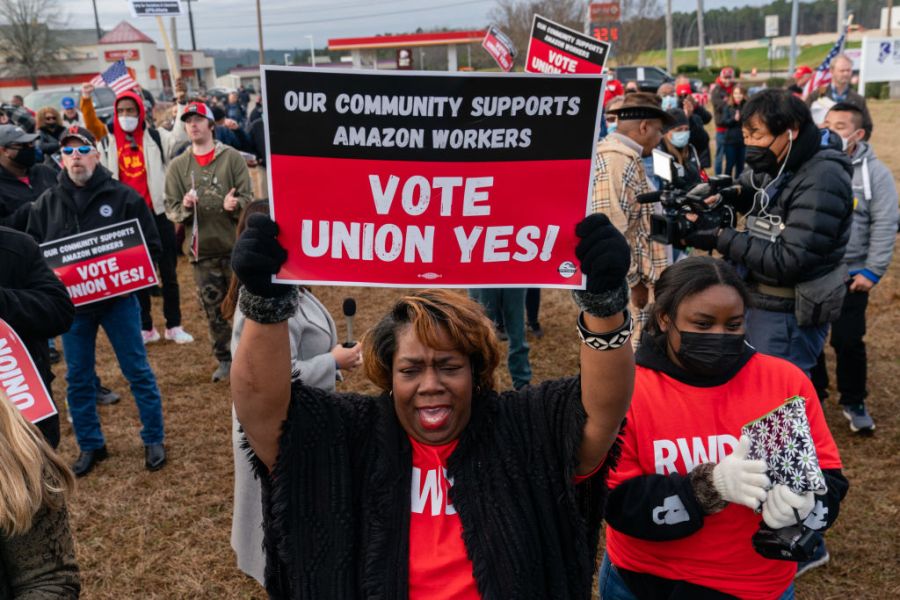Meet Scabby, the Giant Inflatable Rat Fighting for Labor Rights

Throughout the years, plenty of lovable mascots have emerged that evoke instant associations with brands, teams, and even movements. Just think — there’s the righteous Kool-Aid man who busts through brick walls with a signature “Oh yeah!”; the gentlemanly Mr. Peanut (R.I.P.) who dazzled us all with the twirl of a cane and the glint of a monocle; and even Poppin’ Fresh, everyone’s favorite (or feared) sentient, giggling blob of dough. But then there’s Scabby, who…looms over protests while flashing a fanged grimace. Not your average huggable brand representative, Scabby is a 12-foot-tall rat whose appearance verges on the border of terrifying — but that’s really all part of its appeal.
Despite its less-than-cuddly appearance, Scabby has become an important symbol of the labor movement and recently even scored free speech rights in court. Join us for a fascinating look into the saga of Scabby and how it became an unlikely champion of workers’ rights around the United States.
Who Is Scabby, and Where Did This Creature Come From?

Rats tend to get a bad rap in the media, but a few of them — like Splinter of Ninja Turtles fame and that adorable rodent chef from Ratatouille — have shown us how intelligent and endearing these critters can be. Scabby the Rat, on the other hand, is not the kind of critter who’s out to reform rats’ reputation. With large red eyes, menacing teeth, sharp claws, and trademark belly scabs, Scabby isn’t the kind of mascot you shuffle your kids over to take photos with. This rodent is here to spark change.
Scabby’s tale began in the 1980s at a labor rights protest organized by Chicago’s International Union of Operating Engineers (IUOE) Local 150. In the beginning, Scabby was simply a drawing that a protestor added to a sign — a sign that inspired so many questions from people walking by that the union soon realized Scabby was an enticing conversation starter.
As more and more people stopped to ask why the protestors were waving a giant rat around, workers saw increasing opportunities to educate the passersby about the ongoing labor dispute. But why a rat, and why a scabby one at that? As it turns out, “scab” is labor union slang for strikebreakers — people who step in to work while others are striking, thus undermining the collective bargaining process — hence Scabby’s unsavory appearance and name.
Scabby Becomes Big — Literally

After realizing Scabby drew so much attention, union members decided to take the rat’s newly minted legacy and run with it. Some protestors even began running around in oversized rat costumes, an approach that was ultimately shelved because it turns out that the inside of a big rat costume can get very hot very quickly.
Ultimately, unions decided to commission inflatable Scabbies ranging from 6 to 25 feet in height, similar to the mascots you might see in front of a car lot. As time went on, Scabby’s legacy continued spreading until the creature began appearing at labor union strikes around the country.
Despite the sores and scowl, Scabby has also managed to attract a fan base and is often featured in everything from selfies to union members’ Christmas cards. As Acy Wartsbaugh, an organizer for IUOE 150, explained to NPR, “It’s the iconic symbol of a labor dispute. When they see the rat, without even knowing what’s going on, most people understand that it’s a labor dispute.”
Unfortunately, Scabby has managed to attract a fair share of detractors. “One location we were at, an irate lady came out and started stabbing it with a butcher knife,” Wartsbaugh revealed. “There’s scars right here on the rat where it’s been stitched back up to make it work again, but she was going to town, trying to kill Scabby.” However, responses like this haven’t dissuaded unions’ use of the inflatable rat, which has become an iconic figure that, like the protestors who use it, stands its ground anytime workers’ rights are under threat.
Scabby Scores a Free Speech Win

While Scabby has roamed freely for most of its labor-championing career, it briefly came under fire in late 2020. Then, the rat’s fate ended up in the hands of the National Labor Relations Board (NLRB), a federal agency that enforces U.S. labor laws.
In late 2020, the board was concerned that propping up a giant inflatable rat in front of a business, even as part of a protest, might scare away prospective customers. Not only is Scabby a pretty frightful character, but these days it’s also a clear symbol that the business in question has managed to stir up conflict with a union.
Others argued that the fact Scabby is now widely recognized as the face of worker disputes meant the rat was serving its purpose well. Aside from looking a bit scarier, Scabby’s proponents believed propping up a 12-foot rat in front of a business wasn’t much different from standing in front of it holding protest signs.
In the end, it came down to a matter of the constitutional right to freedom of speech. After deliberating the case, the NLRB ultimately sided with the unions and their rodent friend, dubbing Scabby’s right to appear in front of businesses constitutionally sound in a 3-1 ruling. “This is a protected symbol of free speech, pure as that,” said Ed Maher of the IUOE Local 150.
The Importance of Labor Disputes

Why do labor disputes happen, and what makes them so important? Decades ago, employers essentially treated their workers — which often included children — however they wanted. Unfortunately, this often resulted in everything from lack of fair pay to unsafe working conditions, both of which remained prominent issues well into the 20th century.
During the 1940s and 1950s, labor unions saw a massive surge in popularity in the United States as workers fought back against these and other forms of unfair treatment. The idea was that, while an employer could simply replace one laborer who complained, they’d have a far bigger problem if an entire group of workers all united against the employer to collectively fight for their rights.
Ultimately, laborers realized that they had far more power when they stood together. If the union collectively decided that its workers were being underpaid or mistreated in any way, members could organize labor protests and strikes to make their voices heard and prompt economic disruptions that demonstrated the seriousness of their cause. When a union goes on strike and refuses to work until workers’ demands are met, it can quickly cost the company they’re working for a great deal in profit and change its reputation among consumers.
Things may get even more complicated for the company in question when the union members openly protest and draw public attention to the poor treatment of the workers. This has served as an excellent way for workers to level the playing field by improving their ability to negotiate with powerful businesses and ensure they’re less likely to take advantage of employees. Thanks to unions’ dispute efforts — and thanks to Scabby — the rat race is brighter for workers everywhere.





